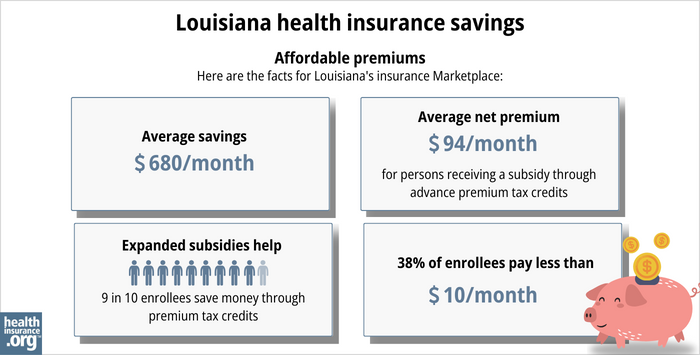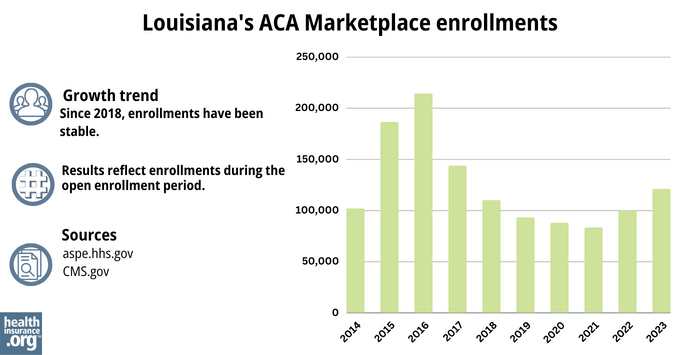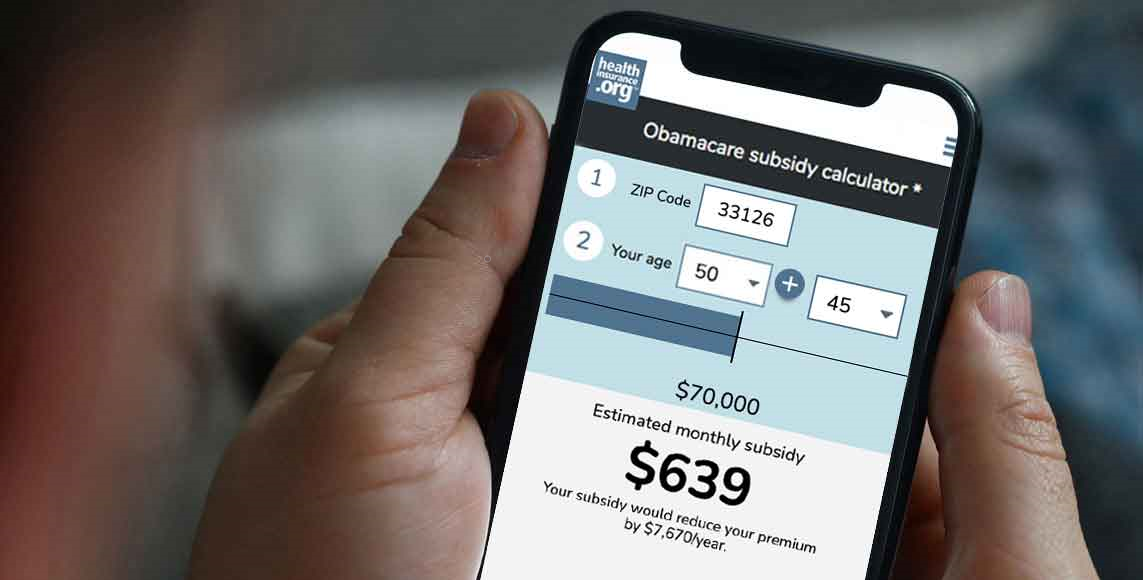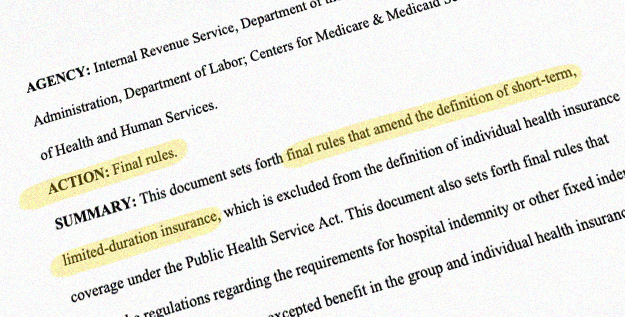Home > States > Health insurance in Louisiana
See your Louisiana health insurance coverage options now.

Find affordable individual and family plans, small-group, short-term, or dental plans through licensed agency partners.

Louisiana Health Insurance Consumer Guide
This guide was created to help make it easier to choose the right health insurance for yourself and your family. A plan from the Affordable Care Act (ACA) Marketplace may be a good choice for many people.
Louisiana uses the federal health insurance exchange to help people sign up for ACA plans. The exchange is also known as the ACA Marketplace or Obamacare Marketplace.
The federal government runs the Louisiana Marketplace website, HealthCare.gov, which lets you shop for health plans from private insurance companies. If you buy a plan from the Marketplace, the government may help pay your premiums through an income-based advance premium tax credit (APTC).
Explore our other comprehensive guides to coverage in Louisiana
Dental coverage in Louisiana

Dental plans in Louisiana cost an average of $41 per month in 2022.1 Compare options to find the right dental plan.

Louisiana’s Medicaid program

In June 2016, Louisiana adopted the ACA Medicaid expansion.2 As of August 2023, Healthy Louisiana, the state’s Medicaid expansion program, covered about 771,000 low-income adults.3

Medicare coverage and enrollment in Louisiana

Use our guide to help you understand Medicare Parts A, B, C, and D, along with Medicare supplement (Medigap) plans. Learn more about Medicare regulations in the state.

Short-term coverage in Louisiana

In Louisiana, short-term health insurance plans can initially last up to 364 days and can be renewed for up to three years. However, a few insurers may have plans with even shorter timeframes and may not allow renewals.4

Frequently asked questions about health insurance in Louisiana
Who can buy Marketplace health insurance?
If these apply to you, you can buy individual and family health insurance from Louisiana’s Marketplace:
- You live in Louisiana.
- You are lawfully present in the U.S.
- You’re not enrolled in Medicare.
- You’re not incarcerated.
Many people, like early retirees not yet on Medicare, self-employed people, and those who work for small businesses without health benefits, buy health insurance on the Marketplace.
Eligibility for financial assistance, such as premium subsidies and cost-sharing reductions, is based on your income and how it compares with the cost of the second-lowest-cost Silver plan in your area (which depends on your age and location). In addition, you may qualify for financial assistance in the Marketplace if:
- You don’t have access to affordable health coverage through your employer. If your employer offers coverage, but you feel it’s too expensive, our Employer Health Plan Affordability Calculator can help you understand if you might qualify for premium subsidies.
- You’re not eligible for Medicaid/CHIP.
- You’re not eligible for premium-free Medicare Part A.5
- You file a joint tax return with your spouse, if you’re married.6
- You can’t be claimed by someone else as a tax dependent.6
When can I enroll in an ACA-compliant plan in Louisiana?
You can sign up for ACA-compliant individual and family health plans in Louisiana between November 1 and January 15. This is known as open enrollment.7 (Note that the deadline for 2024 enrollment has been extended through January 16, 2024, due to the federal holiday on January 15.)8
- Coverage starts on January 1 if you enroll by December 15.
- Coverage starts February 1 if you enroll between December 16 and January 15 (January 16, in 2024).
After January 15, you can sign up for or make changes to an ACA Marketplace health through a special enrollment period (SEP). To qualify for a SEP, you’ll need a qualifying life event.
But there are instances where you don’t need a qualifying life event to apply outside of open enrollment. For example:
- If you’re eligible for premium tax credits and your income is not more than 150% of the poverty level, you can enroll anytime until at least 2025.9
- If you’re a Native American, you can enroll whenever necessary.10
- If you lose Medicaid or CHIP between March 31, 2023 and July 31, 2024, you can enroll through the extended SEP.11
How do I enroll in a Marketplace plan in Louisiana?
You can enroll in a Louisiana health insurance Marketplace plan:
- Directly through HealthCare.gov, the ACA exchange website
- By phone at (800) 318-2596 (TTY: 1-855-889-4325). Talk to an agent 24 hours a day, seven days a week, except for holidays.
- With the help of agents, navigators, or certified application counselors (available over the phone or online; some offer in-person meetings as well).
- Via an approved enhanced direct enrollment entity.12
How can I find affordable health insurance in Louisiana?
In Louisiana, people who can’t get health plans through an employer may find affordable coverage on the ACA Marketplace (HealthCare.gov). Under ACA, you may qualify for income-based subsidies called Advance Premium Tax Credits (APTC). These credits lower your premiums.
During the 2023 open enrollment period:
- 94% of Marketplace enrollees in Louisiana qualified for premium subsidies, saving on average about $680 monthly in premiums.13
- With subsidies, enrollees paid an average of just $94 per month for health coverage.13

Source: CMS.gov13
In addition to APTC, you may qualify for cost-sharing reductions (CSR), which help you pay for your deductibles and out-of-pocket expenses.14 CSR benefits are only available on Silver-level plans, and your income must be no more than 250% of the federal poverty level to be eligible for CSR.15
Another way to find affordable health insurance in Louisiana is through the state’s Medicaid program. Louisiana has expanded Medicaid under the ACA, so adults under age 65 are eligible for Medicaid with household income up to 138% of the poverty level.
Short-term plans may be a low-cost alternative for those who are not eligible for employer coverage, Medicare, Medicaid, or Marketplace subsidies. However, short-term plans are not subject to ACA regulations, so they generally offer less robust benefits and fewer consumer protections.
How many insurers offer Marketplace coverage in Louisiana?
Five insurers are offering 2024 health coverage through Louisiana’s Marketplace, according to the federal data file for Marketplace insurer participation.16
There were six insurers in the Louisiana Marketplace in 2023, but Vantage Health Plan has been acquired by Blue Cross Blue Shield of Louisiana and Vantage policies are not being offered for 2024 (members can transition to a BCBSLA policy or pick a different replacement policy during open enrollment).17
Are Marketplace health insurance premiums increasing in Louisiana?
Louisiana’s individual market insurers implemented the following rate increases for 2024,18 which amounted to an average rate increase of 1.3%:19
Louisiana’s ACA Marketplace Plan 2024 Approved Rate Increases by Insurance Company |
|
|---|---|
| Issuer | Percent Increase |
| Ambetter from Louisiana Healthcare Connections | 1.47% |
| Blue Cross Blue Shield of Louisiana | 5.2% |
| CHRISTUS Health Plan Louisiana | 4.18% |
| HMO Louisiana (BCBSLA subsidiary) | 1.5% |
| UnitedHealthcare | -6.83% |
| Vantage Health Plan | exiting market |
It’s important to note that rate increases apply to the full-price premiums (i.e. before any premium subsidies are applied). However, because most people using Louisiana’s exchange receive premium tax credits, they don’t have to pay the entire cost.20 If you qualify for these subsidies, your actual rate change depends on your plan’s cost and the subsidy amount you receive.
In 2021, the American Rescue Plan expanded the availability of premium subsidies. These changes were extended through 2025 by the Inflation Reduction Act.21
For perspective, here’s a summary of how average full-price premiums have changed over time for individual/family health insurance in Louisiana:
- 2015: Average increase of 12%.22
- 2016: Average preliminary increase of 15.4%.23
- 2017: Average increase of 26.8%.24
- 2018: Average increase of 21.4%.25
- 2019: Average decrease of 6.4%.26
- 2020: Average increase of 11.7%.27
- 2021: Average increase of 6.9%.28
- 2022: Average increase of 4.8%.29
- 2023: Average increase of 2.5%.30
How many people are insured through Louisiana’s Marketplace?
During the open enrollment period for 2024 coverage, 212,493 people enrolled in private health plans through the Marketplace in Louisiana.31
This dwarfed enrollment in recent years (see chart below), and was almost as high as enrollment had been in 2016, just before Medicaid expansion took effect in Louisiana (Medicaid expansion generally results in a decrease in Marketplace enrollment, as people with income between 100% and 138% of the poverty level transition from being eligible for Marketplace subsidies to being eligible for Medicaid.)
The enrollment growth in recent years is due in part to the subsidy enhancements created by the American Rescue Plan and Inflation Reduction Act.
And the enrollment growth for 2024 is also partially due to the “unwinding” of the pandemic-era Medicaid continuous coverage rule. Louisiana Medicaid began to disenroll people from the program in mid-2023. CMS reported that by October 2023, more than 28,000 Louisiana residents had transitioned from Medicaid to Marketplace coverage.32

Source: 2014,33 2015,34 2016,35 2017,36 2018,37 2019,38 2020,39 2021,40 2022,41 202342
What health insurance resources are available to Louisiana residents?
HealthCare.gov
The official website where residents of Louisiana can shop for and buy health insurance plans that meet their needs.
Department of Health & Hospitals
This is a governmental body responsible for health services and programs in Louisiana.
Louisiana Department of Insurance
The Louisiana Department of Insurance provides various resources related to health insurance, helping people understand their options and make informed choices.
Medicare Rights Center
A national organization that offers assistance and information about Medicare through its website and call center.
Louisiana Senior Health Insurance Information Program (SHIP)
Assists people on Medicare, providing information and guidance about their health insurance options.
Louisiana Department of Health – Medicaid
Oversees the state’s Medicaid program, which provides health coverage for eligible low-income individuals and families.
Louise Norris is an individual health insurance broker who has been writing about health insurance and health reform since 2006. She has written dozens of opinions and educational pieces about the Affordable Care Act for healthinsurance.org.
Footnotes
- "Louisiana dental insurance guide 2023” healthinsurance.org, Accessed September 2023 ⤶
- “Louisiana Health Insurance Survey” LA.gov, Accessed September 2023 ⤶
- “Healthy Louisiana Expansion Dashboard” LA.gov, Aug. 3, 2023 ⤶
- "Availability of short-term health insurance in Louisiana” healthinsurance.org, April 6, 2023 ⤶
- Medicare and the Marketplace, Master FAQ. Centers for Medicare and Medicaid Services. Accessed November 2023. ⤶
- Premium Tax Credit — The Basics. Internal Revenue Service. Accessed MONTH. ⤶ ⤶
- “When can you get health insurance?” HealthCare.gov, 2023 ⤶
- Marketplace Plan Year 2024 Open Enrollment Fact Sheet. Centers for Medicare and Medicaid Services. October 2023. ⤶
- “An SEP if your income doesn’t exceed 150% of the federal poverty level” healthinsurance.org, Feb. 1, 2023 ⤶
- “Who doesn’t need a special enrollment period?“ healthinsurance.org, Accessed August 2023 ⤶
- “Temporary Special Enrollment Period (SEP) for Consumers Losing Medicaid or the Children’s Health Insurance Program (CHIP) Coverage Due to Unwinding of the Medicaid Continuous Enrollment Condition– Frequently Asked Questions (FAQ)” CMS.gov, Jan. 27, 2023 ⤶
- “Entities Approved to Use Enhanced Direct Enrollment” CMS.gov, April 28, 2023 ⤶
- “2023 Marketplace Open Enrollment Period Public Use Files” CMS.gov, March 2023 ⤶ ⤶ ⤶
- Saving money on health insurance; Cost-sharing reductions. HealthCare.gov. Accessed November 2023. ⤶
- “Federal Poverty Level (FPL)” HealthCare.gov, 2023 ⤶
- 2024 QHP Landscape Data. HealthCare.gov. Accessed November 1, 2023. ⤶
- Vantage is Becoming Blue Cross and Blue Shield of Louisiana. Vantage Health Plan. Accessed November 1, 2023. ⤶
- “Louisiana Rate Review Submissions” HealthCare.gov, 2023 ⤶
- Open Enrollment for Health Insurance Coverage Underway. Louisiana Department of Insurance. November 15, 2023. ⤶
- “Effectuated Enrollment: Early 2023 Snapshot and Full-Year 2022 Average” CMS.gov, March 15, 2023 ⤶
- “Fact Sheet: What happens to premiums if the extra help from the American Rescue Plan expires?” HHS.gov, June 22, 2022 ⤶
- Analysis Finds No Nationwide Increase in Health Insurance Marketplace Premiums. The Commonwealth Fund. December 2014. ⤶
- Louisiana: *Requested* 2016 Weighted Avg. Rate Hikes: 15.4%. ACA Signups. September 2015. ⤶
- Avg. UNSUBSIDIZED Indy Mkt Rate Hikes: 25% (49 States + DC). ACA Signups. October 2016. Approved as filed: Health Rate Filing Search for Individual and Small Group Markets. Louisiana Department of Insurance. Accessed November 2023. ⤶
- Louisiana: APPROVED Rate Hikes: 7.2% If CSRs *Are* Paid, 21.4% If They *Aren’t*. ACA Signups. September 2017. ⤶
- Obamacare premiums to drop in Louisiana in 2019 after years of rate hikes. The Advocate. August 2018. ⤶
- Louisiana: *Final* Avg. 2020 ACA Premiums: 11.7% Increase. ACA Signups. October 2019. ⤶
- Louisiana: Preliminary Avg. 2021 ACA Premiums: +6.9% Indy, +5.2% Sm. Group (Unweighted). ACA Signups. October 2020. ⤶
- Louisiana: 2022 ACA Premiums: +4.8% Indy, +6.9% Sm. Group. ACA Signups. September 2021. ⤶
- Louisiana: Final Avg. Unsubsidized 2023 #ACA Rate Changes: +2.5% (Unweighted). ACA Signups. November 2022. ⤶
- Marketplace 2024 Open Enrollment Period Report: Final National Snapshot. Centers for Medicare and Medicaid Services. January 2024. ⤶
- HealthCare.gov Marketplace Medicaid Unwinding Report. Centers for Medicare and Medicaid Services. Data through October 2023. ⤶
- “ASPE Issue Brief (2014)” ASPE, 2015 ⤶
- “Health Insurance Marketplaces 2015 Open Enrollment Period: March Enrollment Report”, HHS.gov, 2015 ⤶
- “HEALTH INSURANCE MARKETPLACES 2016 OPEN ENROLLMENT PERIOD: FINAL ENROLLMENT REPORT” HHS.gov, 2016 ⤶
- “2017 Marketplace Open Enrollment Period Public Use Files” CMS.gov, 2017 ⤶
- “2018 Marketplace Open Enrollment Period Public Use Files” CMS.gov, 2018 ⤶
- “2019 Marketplace Open Enrollment Period Public Use Files” CMS.gov, 2019 ⤶
- “2020 Marketplace Open Enrollment Period Public Use Files” CMS.gov, 2020 ⤶
- “2021 Marketplace Open Enrollment Period Public Use Files” CMS.gov, 2021 ⤶
- “2022 Marketplace Open Enrollment Period Public Use Files” CMS.gov, 2022 ⤶
- “Health Insurance Marketplaces 2023 Open Enrollment Report” CMS.gov, 2023 ⤶







